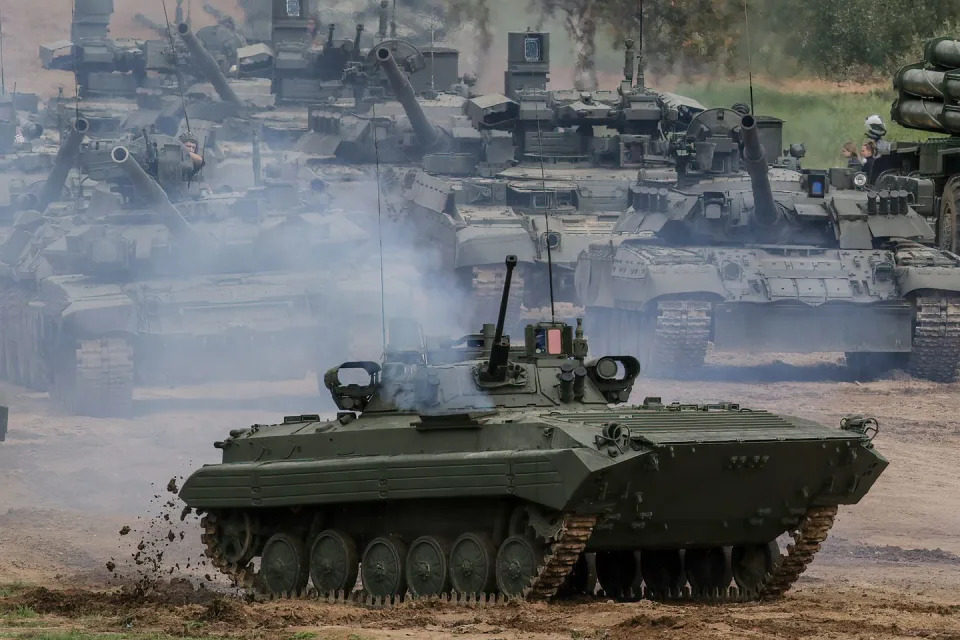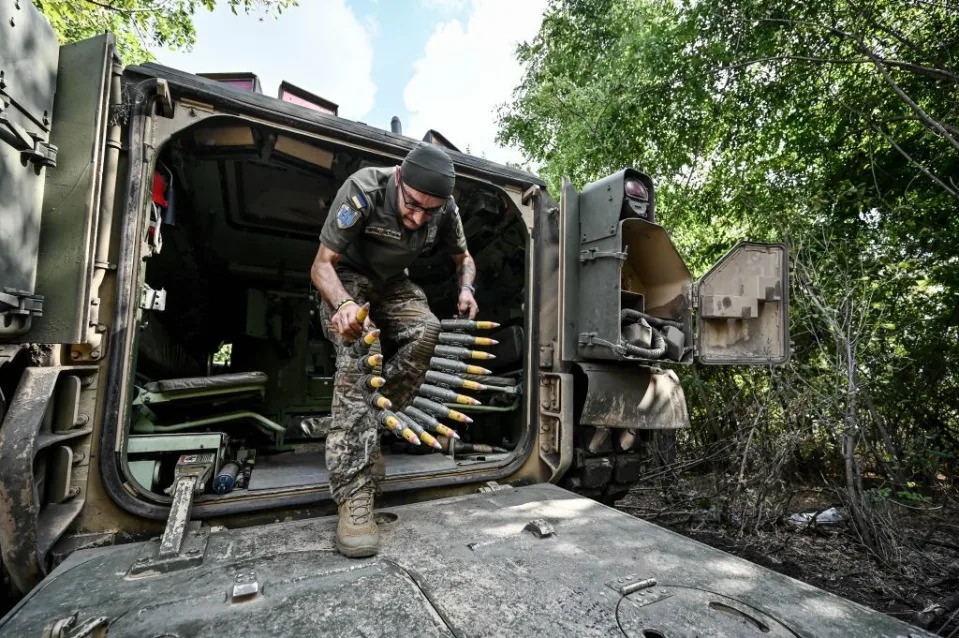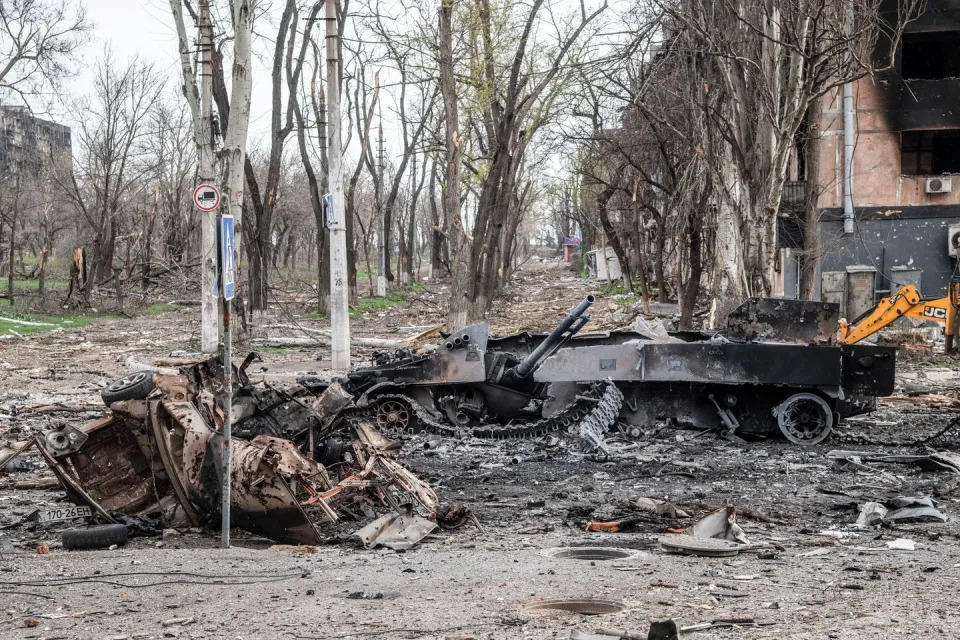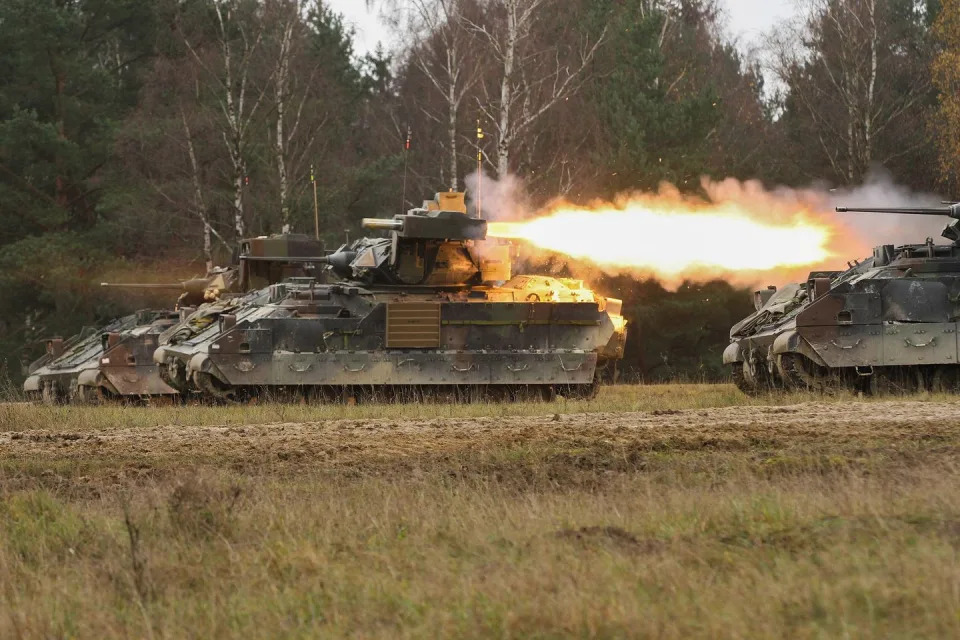WW3.0
Watch a Bradley and a BMP Fighting Vehicle Get Up Close and Personal in a Rare BattleSébastien Roblin
Tue, December 19, 2023

A Bradley and a BMP Got Up Close And Personal
Tue, December 19, 2023

A Bradley and a BMP Got Up Close And Personal
Anadolu - Getty Images
Short-range engagements between armored vehicles tend to be highly lethal. At proverbial knife-fighting range, armor piercing shells strike with maximum kinetic energy, and enemies are more likely than usual to pop up from concealment with the right angle to hit vulnerable side or rear-armor plating. And should the battle tilt against one side, the odds of that side disengaging unscathed are poorer.
All of these factors mean that it’s rare for such close fights to get caught on camera. Though, it does happen—the grisly duel between a German Panther and U.S. Pershing tank in the battle of Cologne near the end of World War II is a famous example.
But in November, the camera of a Ukrainian drone captured one such close battle between two late Cold War war machines: a Ukrainian M2A2 ODS Bradley infantry fighting vehicle (IFV) and its Soviet counterpart, a BMP fighting vehicle.
Short-range engagements between armored vehicles tend to be highly lethal. At proverbial knife-fighting range, armor piercing shells strike with maximum kinetic energy, and enemies are more likely than usual to pop up from concealment with the right angle to hit vulnerable side or rear-armor plating. And should the battle tilt against one side, the odds of that side disengaging unscathed are poorer.
All of these factors mean that it’s rare for such close fights to get caught on camera. Though, it does happen—the grisly duel between a German Panther and U.S. Pershing tank in the battle of Cologne near the end of World War II is a famous example.
But in November, the camera of a Ukrainian drone captured one such close battle between two late Cold War war machines: a Ukrainian M2A2 ODS Bradley infantry fighting vehicle (IFV) and its Soviet counterpart, a BMP fighting vehicle.
The encounter took place near a rail junction on the outskirts of Stepove (a key northern suburb of the fortified city of Avdiivka) which has come under intense Russian assaults since October. As often happens, the fracas took place at the intersection of tree lines, which serve as natural defensive positions and barriers to enemy lines of sight—but provide no cover from drones flying overhead.
Donated by the United States, the Bradley was operated by the Ukrainian Army’s 47th Assault Brigade, which saw a difficult combat debut spearheading Ukraine’s counteroffensive earlier in June. It’s not possible to tell exactly what its adversary was—it could have either been a BMP-2 armed with a 30-millimeter autocannon, or a slightly better-armored BMP-3 with an additional 100-millimeter cannon next to its 30-millimeter gun.
Donated by the United States, the Bradley was operated by the Ukrainian Army’s 47th Assault Brigade, which saw a difficult combat debut spearheading Ukraine’s counteroffensive earlier in June. It’s not possible to tell exactly what its adversary was—it could have either been a BMP-2 armed with a 30-millimeter autocannon, or a slightly better-armored BMP-3 with an additional 100-millimeter cannon next to its 30-millimeter gun.

Russian Army BMP-2 infantry fighting vehicle in front of a unit of main battle tanks in August 2021, a half year prior to hostilities with Ukraine. This variant mounts a 30-millimeter A272 autocannon in addition to a Konkurs anti-tank guided missile launcher and machinegun, and sports a maximum 30-millimeters of frontal armor. SOPA Images - Getty ImagesMore
The BMP was concealed on the edge of dense woods, while the Bradley had crept forward with much scantier cover on the other side of perpendicular tree line. But the Bradley’s crew was evidently aware of the BMP’s presence, while the reverse doesn’t appear true.
Perhaps the drone’s operators passed on information on the BMP’s position to the Bradley. But Bradleys also have superior thermal sights, which they may have used to spot the BMP first.
Fourteen seconds into the video, the Bradley’s M242 Bushmaster autocannon begins spitting out M792 25-millimeter (1 inch) high-explosive-incendiary fragmentation shells. Several rounds detonated prematurely upon hitting intervening trees and ground. But other small blasts flashed as they detonated against the BMP’s hull.
If the Bradley crew had employed armor-piercing M791 rounds instead of fragmenting M792s, the engagement may have ended quickly as the rounds entered the vehicle. But perhaps the Bradley’s gunner hadn’t expected to run into enemy armored vehicles and didn’t have AP ammo loaded.

Bradley gunner ’Molfwar’ ("Sorcerer") holds a belt of 25-millimeter M792 fragmentation shells in September 2023. The orange-banded anti-personnel shells can be distinguished from pointier, black-tipped M791 armor-piercing discard-sabot shells.NurPhoto - Getty Images
Instead, after coming under fire for 15 seconds, the BMP’s surprised crew kicked the vehicle into motion—first lurching out of the woods, and then racing away from the attacking Bradley. Meanwhile a munition (perhaps a mortar round) blasted the snow just short of the Bradley at the 27 second mark.
The BMP’s escape maneuver, however, further exposed its thinner side and rear armor to the Bradley’s shells, and the BMP blunders into the blast radius of a 155-millimeter cluster munition artillery (DPICM) strike—one that would otherwise have missed it 42 seconds in. The likely M483A1 or M864 munition released either 72 or 86 armor-piercing bomblets, each with shaped-charges capable of penetrating up to 70 millimeters of armor.
The cluster strike appeared to be aimed at a spot that would ordinarily be considered unsafe (“danger close”) for the friendly Bradley.
In the recording’s final seconds, repeated small explosions can be seen rippling off the BMP’s hull from the combined cluster bomblet and 25-millimeter shell strikes.
The video then ends, leaving the BMP’s fate unclear. Perhaps the cut is meant to hide that the vehicle managed to escape.
But that seems unlikely—at the end of the video, the BMP is now in the open, the Bradley crew appears to have found the range, and the BMP has already sustained multiple hits. And should passengers have attempted to disembark, the rear ramp would have opened facing the Bradley.
The 47th Brigade’s Telegram channel notes, regarding this engagement, that “the American vehicles [Bradleys] are at their most effective in the Avdiivka front. There are more opportunities to maneuver and destroy the Russians.”
The brigade’s clip also includes footage of an attack by a First-Person View (FPV) kamikaze drone on a BMP, which may be the same one seen in the video.
Another video in the Avdiivka area captures a flank ambush (by a Bradley) of a platoon of three MT-LB tracked utility APCs. These vehicles are even more lightly armored than BMPs, and lack weapons that can harm a Bradley. In less than a minute, all three MT-LBs are reduced to burning wrecks.
While Bradleys have tougher armor than BMPs, they’re hardly immune to enemy weapons—particularly, anti-tank guided missiles, artillery, and tank shells. Russia finally managed to captured and recover a Bradley that had been abandoned by its crew near Stepove on December 6.
By mid-December of 2023, the Oryx blog counted 29 Bradleys destroyed and another 31 seen damaged or abandoned. This means that of the 190 Bradleys (including four specialized M7 BFIST artillery spotting models) that the U.S. had given Ukraine, one-sixth of that fleet has been destroyed and another sixth is (or was) in need of repair after seven months of high intensity combat.
Meanwhile, confirmed Russian losses of various marks of BMPs (destroyed, abandoned, or captured) over nearly two years of fighting exceed 2,100 hulls.

A BMP-3 destroyed on Azovstalska St. in Mariupol in April 2022, before the city’s captured by Russian forces. Note the two guns on the turret, 30- and 100-millimeter caliber. Unlike its predecessors, the BMP-3 is only operated by Russia’s military, though Ukraine has captured over 60 BMP-3s.SOPA Images - Getty Images
Bradley versus BMP
The Bradley infantry fighting vehicle was developed in part as a response to the Soviet Union’s BMP-series of infantry fighting vehicles (IFVs), which combined troop-carrying capacity with cannon and anti-tank missile armament.
The U.S. Army’s mechanized infantry and cavalry branches wanted an IFV that could also take on BMPs in a head-to-head fight—something its boxy M113 ‘battle taxi’ APCs, armed with.50-caliber machine guns, had little hope of doing.
Ultimately, the Bradley family of vehicles clocked in at 25-30 tons, compared to the 13-19 tons of various BMP marks. Most of that difference has to do with armor—the front armor of a Bradley is resilient to armor piercing shells from a BMP-2’s 30-millimeter autocannon, while a BMP’s can be made into Swiss cheese by armor piercing rounds from a Bradley’s 25-millimeter gun. That said, a BMP-2’s autocannon could still defeat a Bradley’s side or rear armor.

Bradley from B Company of the 12th Cavalry Regiment launches a TOW missile at the Grafenwoehr training range in Germany in November 2014.Capt. John Farmer/U.S. Army - Wikimedia Commons
Both Bradleys and BMPs are also armed with powerful anti-tank guided missiles, which could reliably destroy each other. But these require the use of semi-automatic wire-guidance—a method which is actually less likely to hit targets at short range than long distance. In the Stepove battle, the two vehicles may have been close to minimum arming range (65 meters for a Bradley’s TOW, 70 for a BMP-2’s Konkurs missile). The intervening brush might also have snagged a missile’s wire-guidance cables.
While the Bradley has technical advantages over the BMP, the decisive factor in the engagement recorded in Stepove was that the Bradley crew spotted and hit the BMP first. Historically, that predicts the winner of armored vehicle battles more than any other factor.
The Bradley’s first strike may have come down to the skill and training of the Ukrainian crew, the benefit of intel from the overflying drone or the Bradley’s thermal optics, or transparent dumb luck—or, perhaps, a combination of all three.
FASCIST STUDIES
THE ROLE OF THE TANK IN WAR
J.F.C. "Boney" Fuller - Wacko Genius of Armored Warfare
Major General John Frederick Charles Fuller was, during World War I and through the early 1930s, the British army’s tank warfare go-to guy. He was the man who taught the Wehrmacht how to blitzkrieg, George Patton how to rumble and the Israelis how to kill Syrians.
Armyupress.army.mil
Armyupress.army.mil

No comments:
Post a Comment